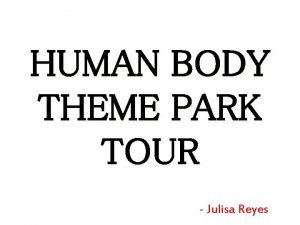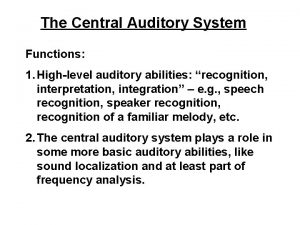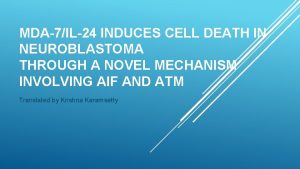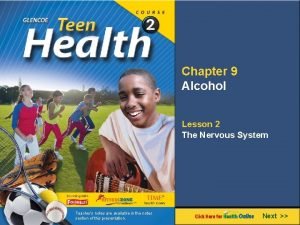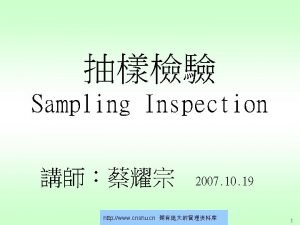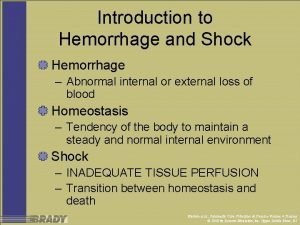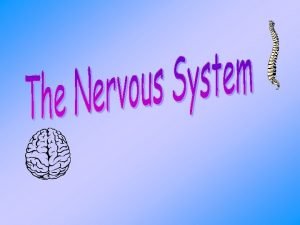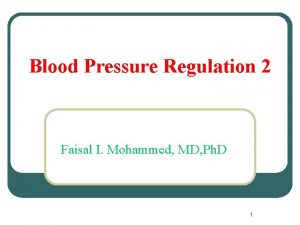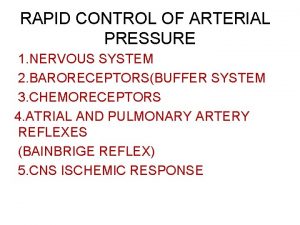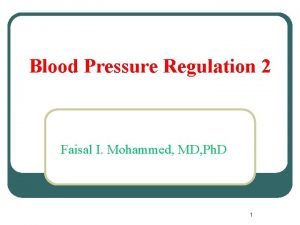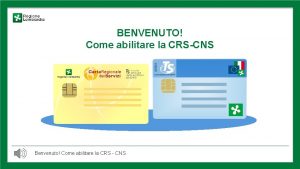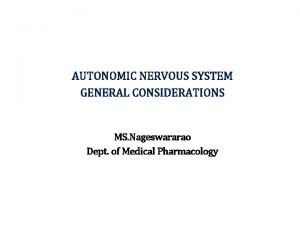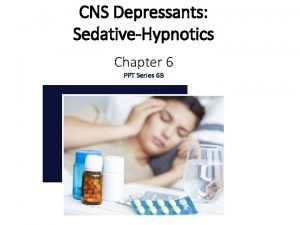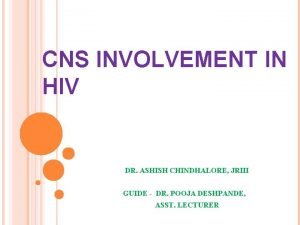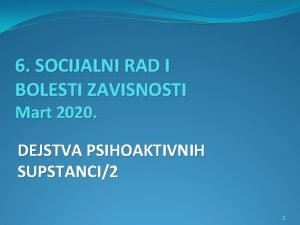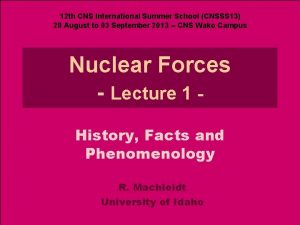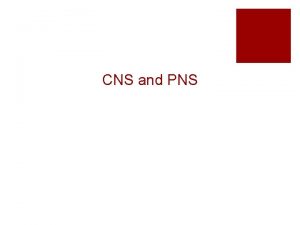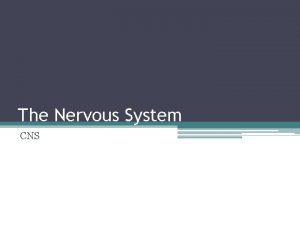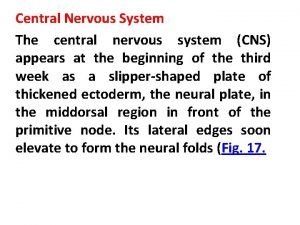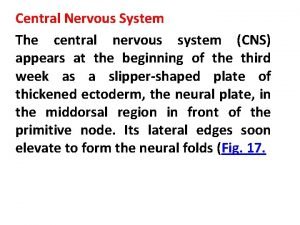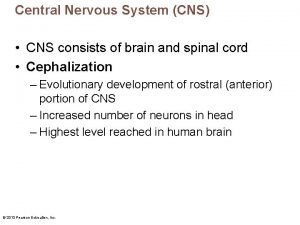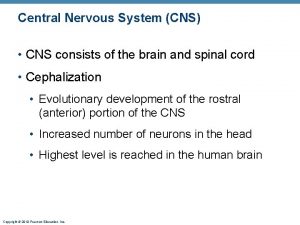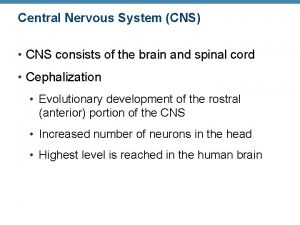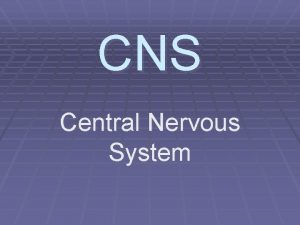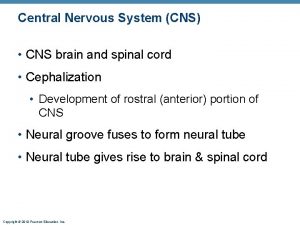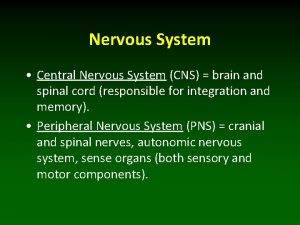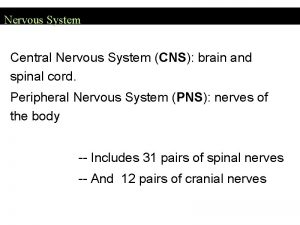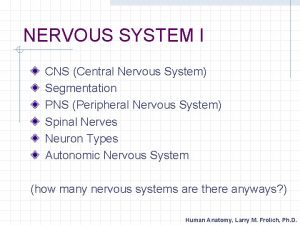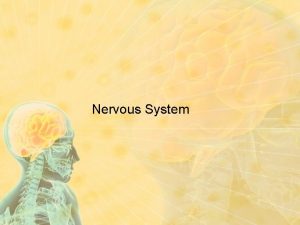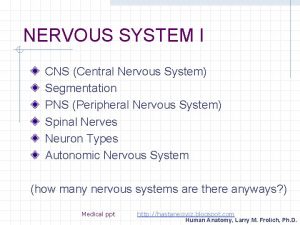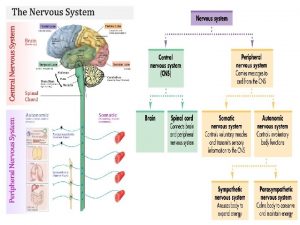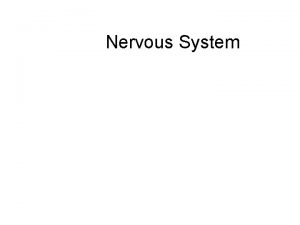Your Nervous System Central Nervous System Explain CNS

























- Slides: 25

Your Nervous System Central Nervous System

Explain CNS Relays messages l Processes information l Analyzes information l

Parts of CNS 1. 2. The ____________

Protections l l 1. 2. 3. 4. Skull and Vertebrae 3 protective layers called ________(outer layer): consists of connective tissues, blood vessels, and nerves. _________(middle layer): elastic and weblike ______(inner layer): contains nerves and blood vessels. _____________ l l a clear watery liquid separates the middle and inner layers Acts as shock absorber exchange of nutrients between blood and nervous system


Section 35 -3 Cerebrum Thalamus Pineal gland Hypothalamus Cerebellum Pituitary gland Pons Medulla oblongata Spinal cord

The Brain l l The brain is the control center of the body It is about ___ of your body weight and uses 20% of your body’s ______

Parts of the Brain l Divided into four parts l l _____________

Cerebrum 1. l l l _____ part of the brain – Learning and Senses 2 hemispheres- Right and Left Connected by the __________ Right side controls- left side Left side controls – right side of body Four sections - LOBES 1. _____ Lobe 2. _____ Lobe 3. _____ Lobe 4. ______ Lobe



Gray Matter vs. White Matter _____– Absence of myelin in masses of neurons accounts for the gray matter of the brain – Cerebral Cortex l _____- Myelinated neurons gives neurons a white appearance – inner layer of cerebrum l

Cerebral Cortex l 3 types of functional areas: 1. Motor 2. Sensory 3. Association Control voluntary motor functions Allow for conscious recognition of stimuli Integration

Cerebellum l l l Second largest located below the cerebrum at back of skull This part is responsible for the _______________


Diencephalon l l Forms the central core of the forebrain 3 paired structures: l l l _____________ All 3 are gray matter


Thalamus l l _____ of the diencephalon Sensory relay station where sensory signals can be edited, sorted, and routed. Also has profound input on motor and ____ function. Not all functions have been elucidated.

Hypothalamus l Functions: l Autonomic regulatory center l l l ______________ l l l Involved in fear, loathing, pleasure Drive center: hunger ______________ Regulation of food intake l l Influences HR, BP, resp. rate, GI motility, pupillary diameter. Can you hold your breath until you die? Contains a satiety center Regulation of water balance and thirst Regulation of sleep/wake cycles Hormonal control l l Releases hormones that influence hormonal secretion from the anterior pituitary gland. Releases oxytocin and vasopressin

Epithalamus l l l Above thalamus Contains the pineal gland which releases _____ (involved in sleep/wake cycle and mood). Contains a structure called the habenula – involved in food and water intake

Brain Stem l Connects the brain to spinal cord l The Two Regions act as “switchboard” l _________"reptile brain"– Controls heart rate, breathing rate, and flow of blood through the blood vessels. l Also anger and aggression come from this part of the brain

Brain Stem l ______ – Relays signals between the cerebrum and the cerebellum l It also controls sleep and consciousness, breathing, bladder control, hearing, equilibrium, taste, swallowing, eye movement and the secretion of saliva and tears.

Lateralization l The fact that certain activities are the almost exclusive domain of one of the 2 hemispheres. l In most people, the left hemisphere has a more control ___________________. l While the right hemisphere is geared towards musical, artistic and other creative endeavors. l Most individuals with left cerebral dominance are __________.

Cross Section of the Spinal Cord Section 35 -3 Gray matter Spinal nerve Central canal White matter Meninges

Spinal Cord _________________ l 31 pairs of spinal nerves l Reflexes processed directly by spinal cord l Reflex – quick, automatic, unconscious responses l l Result of reflex arcs – shortest nerve pathways
 Neural circuits the organization of neuronal pools
Neural circuits the organization of neuronal pools Fundamentals of the nervous system and nervous tissue
Fundamentals of the nervous system and nervous tissue Processes of neurons
Processes of neurons Division of nervous system
Division of nervous system Central nervous system amusement park
Central nervous system amusement park Central. nervous system
Central. nervous system Building vocabulary activity: the central nervous system
Building vocabulary activity: the central nervous system Hydra neurons
Hydra neurons Bser aer
Bser aer What does this graph show
What does this graph show Central nervous system for kids
Central nervous system for kids How to take care of your nervous system
How to take care of your nervous system Ltpd 表
Ltpd 表 Naas cns
Naas cns Cns ischemic response
Cns ischemic response Histology of nervous system ppt
Histology of nervous system ppt Composition of cns
Composition of cns Cns ischemic response
Cns ischemic response Mean arterial pressure
Mean arterial pressure Atrail
Atrail Www.lispa.it cns
Www.lispa.it cns Ans and cns difference
Ans and cns difference Cns depressants ppt
Cns depressants ppt Cns
Cns Depresori cns
Depresori cns Cns international school
Cns international school




